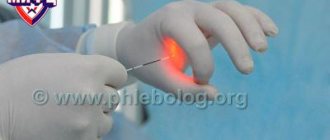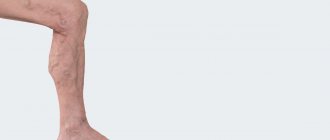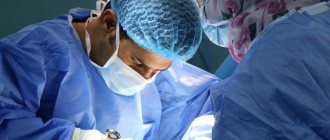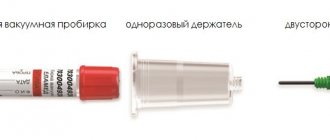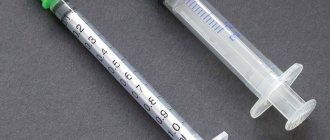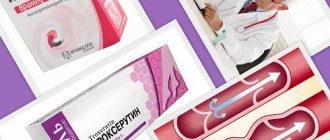Oleinik Evgeniy Mikhailovich
, cardiovascular surgeon, phlebologist.
Phlebology
is a branch of medicine that studies the structure and function of veins, as well as developing methods for diagnosing, treating and preventing their diseases.
Frequent vein diseases found in modern people are:
- Chronic venous insufficiency
of the lower extremities -
varicose veins
of the lower extremities; - Phlebopathy;
- Spider veins;
- Thrombosis of superficial and deep veins, thrombophlebitis;
- Trophic ulcers.
The main reason for the development of chronic venous insufficiency of the lower extremities is human upright posture, and therefore, evolution provided for the special functioning of the veins of the lower extremities with the help of valves.
The operation of the valves resembles the operation of a system of sluices in a river; with each “suction” of blood to the heart, the valves open and raise venous blood.
The relevance of the problem of venous disease of the lower extremities is beyond doubt. With the development of civilization, unfortunately, the level of physical activity decreases, and as a counterbalance to this, static loads, stressful situations, and nutritional disorders increase. Risk factors
development of chronic venous disease (chronic venous disease of the lower extremities) are:
- Sedentary lifestyle;
- Orthopedic problems (flat feet, wearing the wrong shoes);
- Increased static loads on the legs (standing and sitting work);
- Gender (yes, yes, exactly gender, in the fair half of humanity, unfortunately, this disease is more common);
- Use of contraceptives;
- Diabetes;
- Increased weight;
- Age;
- Heredity;
- Pregnancy;
- Smoking.
Main symptoms
chronic venous insufficiency are:
- Heaviness in the legs;
- Swelling of the legs;
- Protruding veins and stars on the skin of the legs;
- In severe cases, the appearance of long-term non-healing wounds on the legs.
Development of chronic venous insufficiency
has a staged, gradually developing character. In the initial stages, the main manifestations of the disease are heaviness and swelling in the legs. This is due to disruption of the normal functioning of the valve system, which causes stagnation of venous blood in the tissues. Subsequently, with the progression of insufficiency of the function of venous valves, blood stagnation intensifies, so-called spider veins appear, and then varicose veins. The increase in stagnation of venous (“bad”, full of “waste”) blood leads to changes at the level of tissues and cells: their nutrition is disrupted, the color of the skin in these places changes, microcracks appear, sensitivity is impaired and trophic ulcers develop.
What methods can be used to examine blood vessels in the legs?
Modern medical practice knows quite a few different ways to determine pathologies of the blood vessels of the legs. How are methods for diagnosing blood vessels of the lower extremities classified? What is the essence of functional research methods? What diseases can be determined using different types of research?
First of all, a distinction is made between invasive and non-invasive methods.
The second classification provides for the division of all diagnostic methods into the following groups:
•Functional;
•Ultrasonic;
•Tomographic;
•X-ray;
•Computer.
Angiography
Angiography is used to examine arterial dysfunction. This type of diagnosis will be called arteriography. If the goal is to determine the condition of the veins, then they talk about phlebography.
In any case, the procedure takes place in a hospital where there is an X-ray angiography room.
In order to determine the condition of the veins and arteries, it is necessary to inject a contrast agent and take x-rays of its progress through the body. Atherosclerosis, thrombosis, dilation of the vessel, aneurysm, thrombophlebitis will be clearly visible.
When to see a doctor about varicose veins
If a person has varicose veins and has any of these symptoms and signs, they should see a doctor.
Inflammation, discoloration or ulceration of the skin or swelling of the calf or leg are more common with problems involving the deeper veins, especially a blood clot. Unexplained pain or swelling in the leg, in particular, suggests a blood clot. Varicose veins by themselves usually do not cause leg swelling.
Varicose veins themselves are relatively harmless, but can cause minor problems from time to time. If the skin covering the vein is thin or irritated, minor trauma from a blow or even shaving can cause bleeding. In this case, raising the leg and applying pressure for a few minutes should be enough to stop the bleeding. If, at any time, the patient feels chest pain or has trouble breathing, this may indicate the presence of a blood clot in the blood vessels of the heart or lungs.
Having varicose veins does not necessarily mean that a person will eventually develop a blood clot or that the blood clot somehow caused them. However, in rare cases, a clot increases pressure in the veins, blocking blood flow. This increased pressure will cause blood to flow back through weakened valves, creating varicose veins.
Magnetic resonance angiography
Electromagnetic waves in a magnetic field help detect occlusions, aneurysms, stenoses, and atherosclerosis. Contrast agents are not needed for this type of diagnosis.
Multislice computed tomography
This method is used to study the vessels of the brain and lower extremities. To detect pathologies, X-rays are used. The tomograph displays the scanned vessels layer by layer on the screen. This produces a three-dimensional image, which clearly shows the condition of the veins and arteries and what the results of their regeneration are after the treatment.
Prevention of varicose veins
A person cannot change their genes, but they can keep their weight under control, exercise, eat healthy foods high in fiber, and wear loose, comfortable clothes whenever possible. If a person is genetically predisposed to developing varicose veins, they may appear despite best efforts.
TED (thromboembolism - deterrent) stockings are the best non-surgical treatment for varicose veins. They prevent skin destruction and exacerbation of varicose veins. Most people have less swelling in their legs and less fatigue at the end of the day when using TED stockings.
Doppler ultrasound
The Doppler effect, better known to physicists, suggests that ultrasound is reflected from moving objects. When special devices based on this effect were invented, determining the specificity of blood flow in the lower extremities became possible in any segment of interest.
Ultrasound ultrasound devices, as a rule, are portable, so it is possible to carry out diagnostics directly near the patient without transporting him.
This method covers vessels from the iliofemoral region to the foot, detecting anomalies in the early stages of their occurrence.
Treatment of varicose veins
Sclerotherapy involves injecting a chemical into a vein, which occludes it and causes scarring. Sclerotherapy is not entirely successful in relieving symptoms and preventing more varicose veins from forming. Complications associated with sclerotherapy include allergic reactions to the chemical used, burning or stinging at various injection sites, inflammation, skin ulcers, and permanent skin discoloration. Wearing compression stockings is usually recommended after sclerotherapy. Doctors who perform this procedure must have special training and experience to avoid complications.
Lasers are used as treatment for veins, but are often used in the treatment of smaller veins, medically called telangiectasia (local over-dilation of small vessels). These veins are small, measuring only up to 1 millimeter in diameter, and are dilated capillaries. Using lasers to treat these small vessels may cause changes in skin color or texture. Often multiple treatments are required. This technique is less useful in treating large varicose veins.
If a person has superficial thrombophlebitis, the doctor usually recommends warm compresses and pain medications. Additional treatment depends on whether the doctor thinks the patient may have an infection.
Surgical intervention for varicose veins
Several surgical procedures are available to relieve varicose veins, but not everyone with varicose veins is a candidate for surgery.
If the patient is pregnant or has recently become pregnant, it is advisable to wait at least 6 weeks after giving birth before considering this option because many varicose veins will disappear after pregnancy.
If the veins are only bothering the patient for cosmetic reasons and the patient is not concerned about pain or inflammation, then surgery may not be the best option.
Most surgical interventions are performed on an outpatient basis. The operation involves either ligating the vein (tying) or removing or retracting (pulling back) the smaller branches. There are risks and benefits to any surgery. These should be discussed with your doctor. Recurrence of varicose veins does occur and may be due to incompetent vein puncher or failure to ligate a vein in the groin.
Avulsion requires many tiny incisions and removal of varicose veins that have been outlined in the skin.
Vein stripping requires a recovery period of 5-10 days before returning to your regular routine. For just vein ligation, a few days off is more than enough. There is the possibility of permanent numbness from damage to the nerves in the skin (for this reason, only the vein up to the knee is usually exposed, and not the vein below the knee). The numbness is only mild and does not cause any future problems.
Endovenous laser therapy is a Lazarus method of destroying a vein. The procedure is usually performed in a doctor's office and takes about 30-45 minutes. A small laser is passed into the vein with guidance from an ultrasound machine. The laser is fired in several places, and the entire procedure is performed with some local anesthesia. Recovery is quick and involves minimal pain. The procedure is relatively new and, with the exception of some mild bruising and a feeling of numbness, no other effects were observed in the short term.
Radiofrequency ablation: Ablation is a similar technique to endovascular laser therapy, but it uses heat to destroy the vein. The probe is placed into the vein under ultrasound and, once in position, the vein is heated along its entire length. The procedure is performed under local anesthesia and takes about 30 minutes. Short-term results are excellent with radiofrequency ablation.
Ligation: Previously, this was a surgical treatment for varicose veins until the advent of the new treatments described above. It usually involved making an incision in the groin and tying off the saphenous vein where it enters the femoral vein. The procedure can be performed under local anesthesia.
The sooner a person begins the lifestyle changes described in the home self-care discussed earlier, the better the chances of preventing the formation of new varicose veins.
Duplex scanning
This is one of the types of ultrasound examination. The result is a color image of the blood flow in the vessel. The method is completely safe, non-invasive and does not expose humans to x-ray radiation.
Since the combination of Dopplerography and B-mode has more capabilities than Doppler ultrasound. This diagnostic method can be performed an unlimited number of times.
The examination takes place in an outpatient clinic, as with other ultrasound examinations, a gel is applied to the patient’s skin, the procedure lasts about half an hour. However, the resulting picture is highly informative. The vessels are visible in both longitudinal and transverse sections, but only in an area that is not very significant in area. Both veins and arteries are equally clearly visible.
Experts believe that the only competitor to such scanning can be X-ray contrast angiography, which is invasive and is not suitable for everyone due to health reasons.
If the goal is to track the dynamics of recovery and it is necessary to determine the condition of the vessels several times, then it is better to resort to the duplex method.
Contraindications to the use of in-depth studies
Hardware methods, despite their information content and the most gentle approaches, still have a number of contraindications. These include:
•Allergies to contrast solution;
•Kidney, heart, liver failure;
•Infectious diseases and inflammations;
•Chronic diseases in the acute stage;
•Psychical deviations.
Diagnosing the condition of blood vessels in pregnant and lactating women, elderly patients, and people with bleeding disorders requires extreme caution.
Warning: Undefined array key “module” in /customers/0/e/9/germanklinik.de/httpd.www/control/config/inc/templates_c/front^7198fc69815638cccb44869b7c86cae91ff823b0_0.file.DefaultGK.tpl.php on line 488 Warning: Attempt to read property “value” on NULL in /customers/0/e/9/germanklinik.de/httpd.www/control/config/inc/templates_c/front^7198fc69815638cccb44869b7c86cae91ff823b0_0.file.DefaultGK.tpl.php on line 488 Warning : Undefined array key “extension” in /customers/0/e/9/germanklinik.de/httpd.www/control/config/inc/templates_c/front^7198fc69815638cccb44869b7c86cae91ff823b0_0.file.DefaultGK.tpl.php on line 490 Warning: Attempt to read property “value” on NULL in /customers/0/e/9/germanklinik.de/httpd.www/control/config/inc/templates_c/front^7198fc69815638cccb44869b7c86cae91ff823b0_0.file.DefaultGK.tpl.php on line 490
Thank you! We have received your request for consultation.
If you want to fill out a Request for Treatment, continue filling out. Having all the necessary data, we will be able to find the best solution to your problem in the shortest possible time
Treatment of chronic venous insufficiency
The treatment method for chronic venous insufficiency depends on the stage of the disease and other factors. They can be divided into 3 large groups:
- Disease prevention;
- Conservative treatment methods;
- Surgical treatment methods.
The main methods of prevention
The development of the disease is a sufficient amount of physical activity (walking during the day) and wearing the right shoes (if you have flat feet, correct it). That is, if there are certain risk factors, it is necessary to take appropriate measures to eliminate them.
Conservative methods
Treatments include taking venotonic drugs, the choice of which is currently quite large.
However, the only drugs whose effectiveness has been proven are drugs containing substances such as hesperidin
and
diosmin
(for example, the drug
Detralex
). The duration of medication is determined individually, depending on the stage of the disease.
An important, and often leading role in the treatment of CVI is played by wearing compression garments of varying degrees of compression. The selection of these products must be approached with special care and trusted only from trusted manufacturers.
If you have varicose veins in your legs, conservative treatment methods alone may not be enough. In this case, surgical treatment methods
. They, in turn, can be minimally invasive (with small incisions) - sclerotherapy, laser coagulation, radiofrequency ablation or classical. When choosing a surgical treatment method, doctors rely on the wishes of the patient, his age and the presence of concomitant diseases. Let us briefly consider separately the two most popular methods of surgical treatment of varicose veins.
